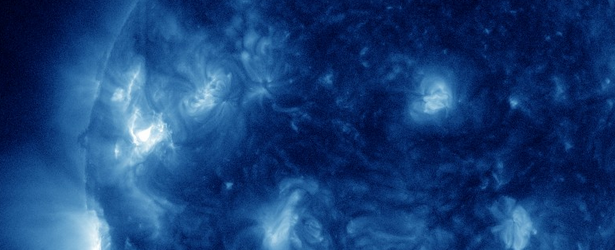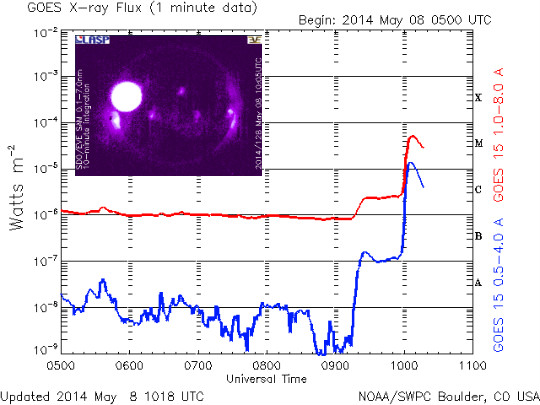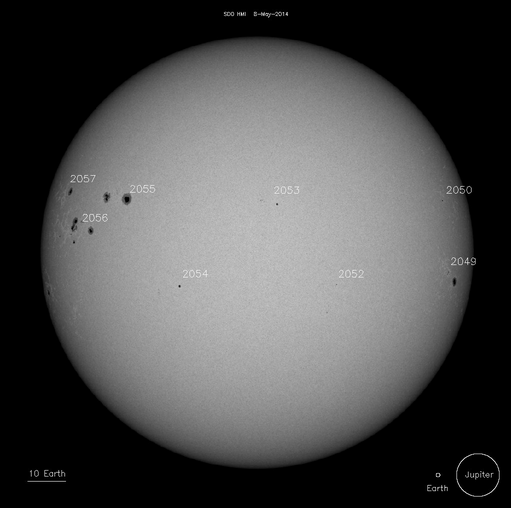Strong, long duration solar flare measuring M5.2 erupted from Region 2056

A strong, long duration, solar flare measuring M5.2 erupted from 'beta-gamma' Region 2056 on May 8, 2014. The event started at 09:20, peaked at 10:07, and ended at 10:18 UTC. This region is located near the eastern limb.
Radio blackout levels reached R2 – moderate. Potential Impacts: Area of impact centered primarily on sub-solar point on the sunlit side of Earth. Radio – Limited blackout of HF (high frequency) radio communication for tens of minutes.
Additionally, a 10cm Radio Burst with peak flux of 390 sfu and lasting 8 minutes was associated with the event. This can be indicative of significant radio noise in association with a solar flare. This noise is generally short-lived but can cause interference for sensitive receivers including radar, GPS, and satellite communications.

Space Weather Message Code: SUM10R
Serial Number: 617
Issue Time: 2014 May 08 1029 UTC
SUMMARY: 10cm Radio Burst
Begin Time: 2014 May 08 1000 UTC
Maximum Time: 2014 May 08 1002 UTC
End Time: 2014 May 08 1008 UTC
Duration: 8 minutes
Peak Flux: 390 sfu
Latest Penticton Noon Flux: 146 sfu
Description: A 10cm radio burst indicates that the electromagnetic burst associated with a solar flare at the 10cm wavelength was double or greater than the initial 10cm radio background. This can be indicative of significant radio noise in association with a solar flare. This noise is generally short-lived but can cause interference for sensitive receivers including radar, GPS, and satellite communications.
***
Space Weather Message Code: SUMXM5
Serial Number: 117
Issue Time: 2014 May 08 1029 UTC
SUMMARY: X-ray Event exceeded M5
Begin Time: 2014 May 08 0920 UTC
Maximum Time: 2014 May 08 1007 UTC
End Time: 2014 May 08 1018 UTC
X-ray Class: M5.2
Optical Class: 2b
Location: N08E54
NOAA Scale: R2 – Moderate
Comment: Flare was from Region 2056.
Potential Impacts: Area of impact centered primarily on sub-solar point on the sunlit side of Earth.
Radio – Limited blackout of HF (high frequency) radio communication for tens of minutes.

Sunspots
There are currently 8 numbered sunspot regions on the disk and the overall trend was one of slight decay or stability. Region 2056 (N04E56, Dko/beta-gamma) appeared to contain mixed polarities in its follower spots and was classified with an increased magnetic complexity as a result.


Sunspots on May 8, 2014. Image credit: NASA SDO / HMI
2049 – Alpha
2050 – Alpha
2052 – Alpha
2053 – Beta
2054 – Alpha
2055 – Beta
2056 – Beta-Gamma
2057 – Alpha
Featured image: NASA SDO / AIA 335 on May 8, 2014 @ 10:01 UTC

Commenting rules and guidelines
We value the thoughts and opinions of our readers and welcome healthy discussions on our website. In order to maintain a respectful and positive community, we ask that all commenters follow these rules.